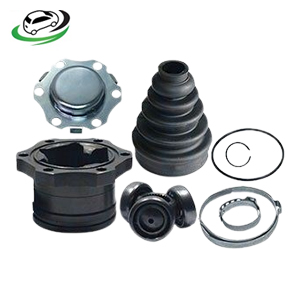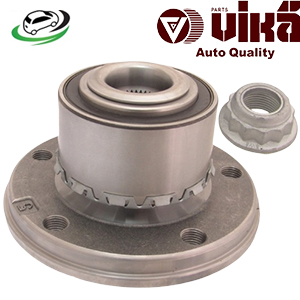-13%
Get Front Wheel Bearing Kit (Complete Hub) VW Touareg 7L 03-2010/ Transporter/Caravelle 7E/SH/SF 7H0498611
A wheel bearing kit is a crucial component of a vehicle’s suspension and steering system, playing a vital role in ensuring smooth and efficient wheel rotation. Properly functioning wheel bearings are essential for maintaining vehicle stability, reducing friction, and prolonging the lifespan of the tires and other related components. This comprehensive guide will delve into the function, components, types, benefits, signs of wear, and maintenance of wheel bearing kits, providing a thorough understanding in 1000 words.
Function of a Wheel Bearing Kit
The primary function of a wheel bearing kit is to support the wheel’s rotation while minimizing friction between the wheel and the axle. Wheel bearings are positioned at each wheel hub, allowing the wheels to spin freely while carrying the vehicle’s weight. They also help in maintaining the correct alignment of the wheels, which is essential for stable steering and handling.
Wheel bearings achieve this by using a series of small, hardened steel balls or rollers that rotate within a race, a smooth, inner surface of a cylindrical housing. This setup reduces friction and wear, allowing the wheel to turn smoothly with minimal resistance.
Components of a Wheel Bearing Kit
A typical wheel bearing kit includes several key components that work together to ensure smooth and efficient wheel rotation:
- Bearing Assembly:
- Function: The bearing assembly is the core component of the kit, containing the ball or roller bearings that reduce friction and allow smooth wheel rotation.
- Types: The assembly can include either ball bearings, which are spherical, or roller bearings, which are cylindrical.
- Race (Inner and Outer):
- Material: The race is typically made of high-strength steel, designed to withstand the pressures and stresses exerted during wheel rotation.
- Function: The race provides a smooth surface for the bearings to roll against, minimizing friction and wear.
- Seal:
- Material: Seals are usually made from rubber or a similar flexible material.
- Function: The seal prevents dirt, debris, and moisture from entering the bearing assembly, which could otherwise cause contamination and premature wear. It also helps to retain the lubrication within the bearing.
- Grease:
- Function: Grease is applied inside the bearing assembly to reduce friction and prevent overheating. It also helps protect the bearings from corrosion.
- Hub Assembly (Optional):
- Function: In some wheel bearing kits, the hub assembly is included. This component connects the wheel to the vehicle and houses the bearing assembly. It may also include the flange that the wheel bolts to.
Types of Wheel Bearings
There are different types of wheel bearings, each suited to specific vehicle applications and driving conditions. The main types include:
- Ball Bearings:
- Design: Ball bearings use spherical balls to allow for smooth rotation. They are versatile and can handle both radial (up and down) and axial (side-to-side) loads.
- Applications: Commonly used in passenger vehicles and light trucks, where the loads and speeds are moderate.
- Roller Bearings:
- Design: Roller bearings use cylindrical rollers instead of balls. They are designed to handle heavier loads but may not accommodate as much axial movement as ball bearings.
- Applications: Often used in heavy-duty vehicles, such as trucks and trailers, where higher load capacity is required.
- Tapered Roller Bearings:
- Design: Tapered roller bearings feature rollers that are wider at one end, allowing them to handle both radial and axial loads effectively.
- Applications: Commonly found in the front wheels of vehicles where steering and suspension movement require bearings that can handle multi-directional forces.
- Precision Ball Bearings:
- Design: Precision ball bearings are made to exacting tolerances and are used in high-performance applications where low friction and high speed are critical.
- Applications: Often used in racing cars, motorcycles, and other high-performance vehicles.
Benefits of a Properly Functioning Wheel Bearing Kit
A properly functioning wheel bearing kit provides several key benefits that contribute to the overall performance, safety, and longevity of a vehicle:
- Smooth Wheel Rotation:
- Reduced Friction: By minimizing friction between the wheel and the axle, wheel bearings ensure that the wheels rotate smoothly. This contributes to a quieter and more comfortable ride.
- Improved Fuel Efficiency:
- Less Rolling Resistance: Properly functioning wheel bearings reduce rolling resistance, allowing the vehicle to move more efficiently and requiring less power from the engine. This can lead to improved fuel economy.
- Enhanced Vehicle Stability:
- Steady Alignment: Wheel bearings help maintain proper wheel alignment, which is essential for stable handling and steering. This is especially important when driving at high speeds or in challenging conditions.
- Increased Tire Lifespan:
- Even Wear: Proper wheel bearing function helps distribute the vehicle’s weight evenly across the tires, reducing uneven wear and extending tire life.
- Safety:
- Reliable Operation: A well-maintained wheel bearing kit ensures that the wheels remain securely attached to the vehicle and can rotate freely. This reliability is crucial for safe driving, particularly during cornering, braking, or emergency maneuvers.
Signs of a Worn or Failing Wheel Bearing Kit
Like any mechanical component, wheel bearings can wear out over time due to constant use, exposure to harsh road conditions, and the natural aging process. Recognizing the signs of a worn or failing wheel bearing is essential for maintaining vehicle safety and performance:
- Grinding or Humming Noise:
- Symptom: A common sign of a failing wheel bearing is a grinding or humming noise that increases with vehicle speed. This noise is caused by the metal components of the bearing rubbing together due to lack of lubrication or wear.
- Uneven Tire Wear:
- Symptom: If the wheel bearing is worn, it can cause the wheel to wobble, leading to uneven tire wear. You may notice that one tire wears out more quickly than the others, or that the tread wears unevenly across the tire’s surface.
- Vibration or Shaking:
- Symptom: A worn wheel bearing can cause the wheel to become misaligned, leading to vibrations or shaking that can be felt in the steering wheel or throughout the vehicle. This is especially noticeable at higher speeds.
- Loose or Wobbly Wheels:
- Symptom: If a wheel bearing is severely worn or damaged, the wheel may feel loose or wobbly when the vehicle is lifted and the wheel is shaken by hand. This indicates that the bearing is no longer securely holding the wheel in place.
- ABS Warning Light:
- Symptom: In some vehicles, a failing wheel bearing can trigger the ABS (anti-lock braking system) warning light. This is because the wheel speed sensor, which is often integrated with the bearing assembly, may be affected by the bearing’s condition.
Maintenance and Replacement
Regular maintenance and timely replacement of the wheel bearing kit are crucial for ensuring the safety and performance of the vehicle:
- Inspection Interval:
- Routine Checks: Wheel bearings should be inspected during regular maintenance intervals, such as during tire rotations or brake inspections. Early detection of wear or damage can prevent more serious issues and costly repairs.
- Lubrication:
- Grease Maintenance: For wheel bearings that are serviceable (not sealed), it’s essential to regularly check and replenish the grease to ensure proper lubrication. This helps prevent friction and overheating.
- Sealed Bearings:
- Maintenance-Free: Many modern vehicles use sealed wheel bearings, which are designed to be maintenance-free. However, they still need to be inspected for wear and replaced when necessary.
- Replacement of Worn Bearings:
- When to Replace: If a wheel bearing is worn, noisy, or showing signs of failure, it should be replaced promptly. Delaying replacement can lead to more severe damage, including potential wheel detachment.
- Professional Installation:
- Complex Procedure: Replacing a wheel bearing can be complex, requiring specialized tools and knowledge of the vehicle’s suspension and drivetrain. It’s recommended to have a professional mechanic perform the replacement to ensure proper installation and alignment.
Follow us on Facebook for more parts.





